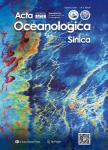Community structure of picoplankton abundance and biomass in the southern Huanghai Sea during the spring and autumn of 2006
Community structure of picoplankton abundance and biomass in the southern Huanghai Sea during the spring and autumn of 2006作者机构:Second Institute of Oceanography State Oceanic Administration Hangzhou 310012 China State Key Laboratory of Satellite Ocean Environment Dynamics Hangzhou 310012 China Key Laboratory of Marine Ecosystems and Biogeochemistry of State Oceanic AdministrationHangzhou 310012 China
出 版 物:《Acta Oceanologica Sinica》 (海洋学报(英文版))
年 卷 期:2010年第29卷第1期
页 面:58-68页
核心收录:
学科分类:090801[农学-水产养殖] 0908[农学-水产] 07[理学] 09[农学] 0713[理学-生态学]
基 金:The National Basic Research Program of China under contract No. 2006CB400605 the scientific research fund of the Second Institute of Oceanography,SOA under contract No. JG0919
主 题:southern Huanghai Sea photosynthetic picoplankton heterotrophic bacteria abundance and carbon biomass distribution
摘 要:During spring and autumn of 2006, the investigations on abundance, carbon biomass and distri- bution of picoplankton were carried out in the southern Huanghai Sea (Yellow Sea, sHS). Three groups of picoplankton-Synechococcus (Syn), Picoeukaryotes (PEuk) and heterotrophic bacteria (BAC) were identified, but Prochlorococcus (Pro) was undetected. The average abundance of Syn and PEuk was lower in spring (5.0 and 1.3×10^3 cells/cm^3, respectively) than in autumn (92.4 and 2.7×0^3 cells/cm^3, respectively), but it was opposite for BAC (1.3 and 0.7×10^6 cells/cm^3 in spring and autumn, respectively). And the total carbon biomass of picoplankton was higher in spring (37.23×11.67) mg/m^3 than in autumn (21.29×13.75) mg/m^3. The ratios of the three cell abundance were 5:1:1 341 and 30:1:124 in spring and autumn, respectively. And the ratios of carbon biomass of them were 5:7:362 and 9:4:4 in spring and autumn, respectively. Seasonal distribution characteristics of Syn, PEuk, BAC were quite different from each other. In spring, Syn abundance decreased in turn in the central waters (where phytoplankton bloom in spring occurred), the southern waters and inshore waters of the Shandong Peninsula (where even Syn was undetected); the high values of PEuk abundance appeared in the central and southern waters and the inshore of the Shandong Peninsula; the abundance of BAC was nearly three order of magnitude higher than that of photosynthetic picoplankton, and high values appeared in the central waters. In autumn, Syn abundance in central waters was higher than that in surrounding waters, while for PEuk abundance, it decreased in turn in the inshore waters of the Shandong Peninsula, the southern waters and the central waters; BAC presented a complicated blocky type distribution. Sub-surface maximum of each group of picopalnkton appeared in both spring and autumn. Compared with the available lit- eratures concerning the studied area, the range of Syn abundance was larger, and the abunda



